Wheat is the most important grain crop and a staple food for more than one-third of the world population. The major area of the wheat in Pakistan lies in Punjab followed by Sindh. However, the yield per hectare is slightly higher in Sindh as compared to Punjab. It ranks first as a cereal crop in the country being followed up by rice only in acreage and production. Wheat crop is subjected to several diseases, which are responsible for reducing its overall production to a great extent because wheat plants in all stages of growth and all-natural environments are subject to various mechanical, environmental, physiologic and biological stresses that interfere with their normal growth and development. Weather, toxicants, pollutants, insects, viruses, fungi, nematodes, bacteria and weeds are primary hazards to wheat production.
The actual number of wheat diseases is unknown, nearly 200 have been reported. Over 100 infectious diseases caused by pathogens and with weeds are parasitic and transmissible from plant to plant. Amongst such diseases, about 50 are routinely important economically (Wiese, 1987). Overall, all diseases are injurious in some areas, in some years and on some plant parts. All parts of the plant are subject to disease and one or more diseases can occur on virtually every plant and in every field. All draw attention because of symptoms or signs and generate great concern because of their effects on the quality and/or quantity of plants, straw or grain.
In Pakistan, 50 diseases are reported to occur (Anonymous, 2000) and are important economically. The rusts are most destructive and also the most widely recognized diseases of wheat crop. They occur in almost all wheat-growing regions of the world, as well as all areas of Pakistan, where wheat crop is grown. The record showed that there has been a severe attack of black stem rust of wheat in 1906-1908 at Mirpurkhas, Sindh (Kamal and Moahal, 1968); yellow or stripe and orange or leaf rust of wheat in 1978 at all over wheat-growing areas of Pakistan (Anonymous, 2000).
However, the causes, symptoms, preventive and curative control measures of some important diseases of wheat, are being summarized hereunder, while for details, the selected bibliography may also help the growers, extension and research workers.
Black stem rust of wheat
Causal Organism: Puccinia graminis tritici
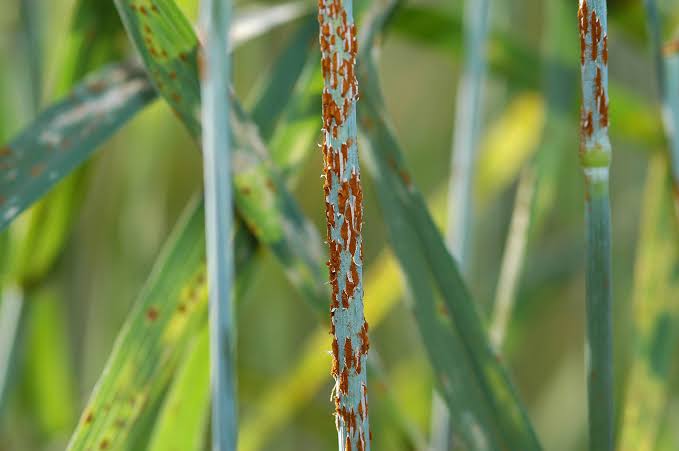
Symptoms: Long and narrow streaks or pustules are formed on all green parts of the plant viz: stem, leaf sheath, leaves, and ear heads. These pustules are brick red in the beginning and become black at the end of the season or when plants reach maturity. Moist and warm weather favors the development of this disease, which usually appears at the heading stage.
Perpetuation: The disease starts from wind-borne spores, which probably travel from hills to plains. The fungus completes its life cycle on barberry plants in Murree.
Control:
- Cultivation of resistant varieties.
- Cultivation of early sowing and early maturing varieties.
- Avoiding thick sowing and heavy irrigation.
- Destroying the weed plants and diseased tillers.
- Avoiding heavy doses of nitrogenous fertilizers.
- Judicious use of potassic fertilizer help in minimizing the susceptibility of plants.
Orange or leaf rust of wheat
Causal Organism: Puccinia recondita
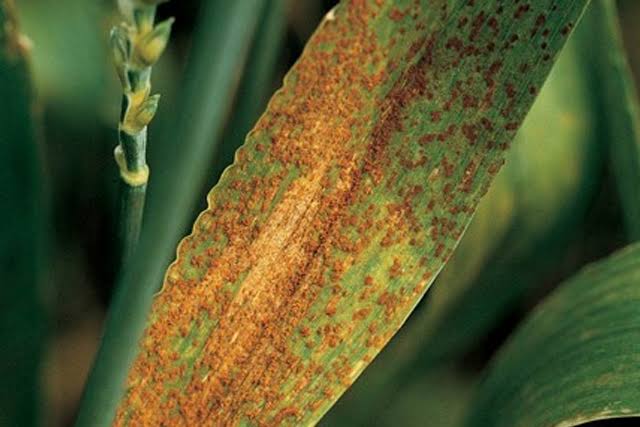
Symptoms: Small pustules are formed scattered chiefly on the surface of leaves, very rare elsewhere. These pustules are orange or brown in the beginning and become black when plants reach maturity. Moist and moderate temperature (18-20c°), favor the development and spread of this disease, which appears earlier than black stem rust.
Perpetuation: As in case of black stem rust.
Control: As in case of black stem rust.
Yellow or stripe rust of wheat
Casual Organism: Puccinia striiformis
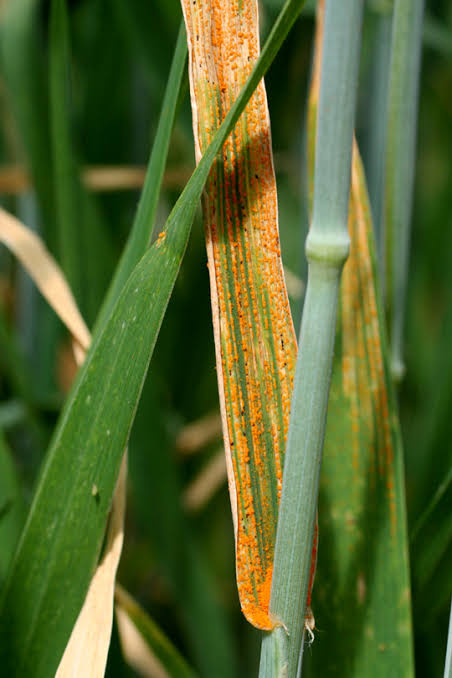
Symptoms: Very small (Smaller than in orange rust) pustules are formed in stripes on leaves and ears (and all green parts of the plants). These pustules are bright yellow in the beginning and become black, when plants reach maturity. Moist and cold weather (about 15c°) favour the disease. It is first of the three rusts that appear on wheat.
Perpetuation: As in stem rust
Control: As in stem rust.
Loose smut of wheat
Casual organisms: Ustilago tritici
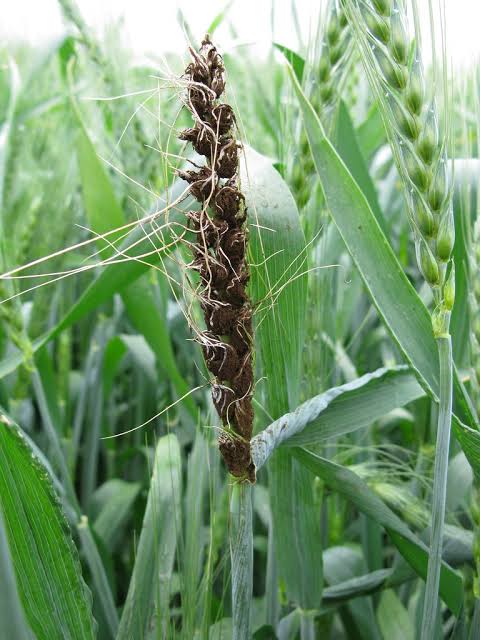
Symptoms: Diseased ears are black and contain black powder of smut spores instead of grains. Initially, spores are covered by a white or silvery membrane, which burst and spores are blown away by the wind leaving behind only naked rachis. Infected ears appear somewhat earlier than the normal ones.
Perpetuation: Perpetuates from infected grains took normally.
Control:
(1) Cultivation of resistant varieties.
(2) To rogue out and destroy the diseased ears.
(3) Use the seed obtained from a healthy crop.
(4) In case the healthy seed is not available, treat the seed as:
(a) Solar energy method:
Soak the seed for 4-5 hours in ordinary water, in the month of May-June or July on a hot day, when the temperature becomes high, dry it in a thin layer (of about 3 inches) from 8 to 12 noon and kept it for planting.
(b) Tapke’s method:
Direct soaking of seed in hot water at 48°c for one hour and fifty minutes. Cool and dry before planting.
(c) Hot water treatment:
Initially, soak the seed in ordinary water for about 4 hours, then dip in hot water at 52°c for 10 minutes. After that cool and dry it in shade before planting.
(d) Anaerobic seed treatment:
The seed may soak for 6 hours in the water, drain, place in an airtight container for 30 hours at 28°c, dry and use for planting.
(e) Chemical seed treatment:
Treat the seed before sowing by using seed dressing fungicides vis: Vitavax, Benlate, Baytan, Topsin, etc. at the rate of 2 g/kg seed.
Flag smut or leat smut of wheat
Causal organism: Urocystis tritici
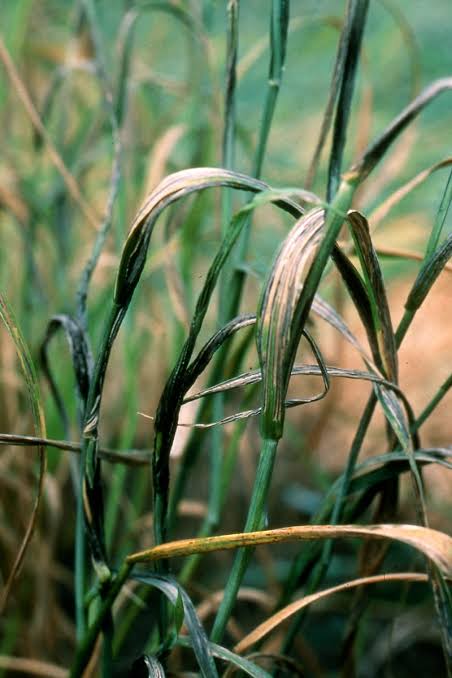
Symptoms: Long dark streaks parallel to the veins appear on leaf blades and become swollen, turn black, rupture and expose black powder with age. The affected leaves wither, twist and drop with result in the death of the whole plant. It may also appear on the sheaths and occur sometimes on the stem and very rarely on the ears. In case of severe infection, every shoot of the plant becomes infected. Very frequently, the ears are replaced by a twisted mass of leaves, do not bear any grain, but if the grain is formed, it is always much shriveled and useless.
Perpetuation: The disease is perpetuated through seed-borne and/or soil-borne spores, which can survive in the soil for up to three years.
Control:
(1) Cultivation of resistant varieties.
(2) Early planting.
(3) Using the wet method of sowing i.e. irrigating just after sowing.
(4) Crop rotation.
(5) Use of healthy seeds obtained from healthy crops and sowing in healthy soil.
(6) Green manuring with guar reduces the incidence.
(7) Rogue out and burn the infected plants.
(8) Chemical seed treatment, as recommended previously.
Old or complete bunt or stinking smut of wheat
Causal organism:- Tilletia foetida or T. caries or T. tritici
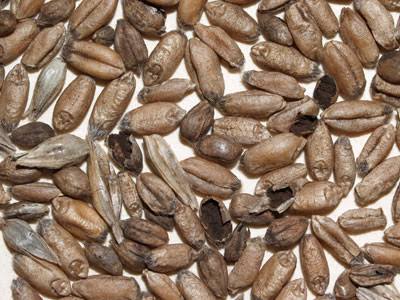
Symptoms: Diseased ears are darker in colour and contain defected grains, which are found to be filled with black powder of scores, on crushing, give out bad smell like that of rotten fish. The diseased plants are sometimes stunted in growth. All the grains of an ear become infected and get very much reduced in size.
Perpetuation: Primarily is seed-borne, but is also soil-borne.
Control:
(1) Cultivation of resistant varieties.
(2) Use of healthy seed in healthy soils.
(3) Prefer early planting, using the wet method of sowing (irrigation just after sowing).
(4) Rogue out and burn the infected ears before harvesting and/or threshing.
(5) Treat the seed with seed dressing fungicides as recommended for loose smut of wheat.
New or partial bunt or karnal bunt of wheat
Causal organism: Tilletia indica
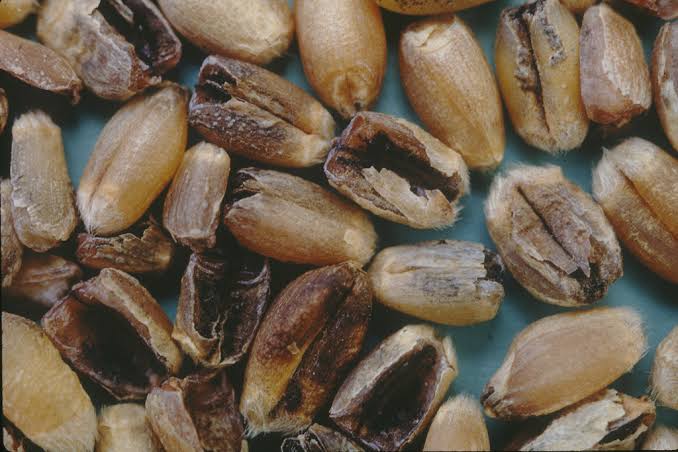
Symptoms: When the grains ripen, the diseased spikelets are more open, the outer glumes spread out giving enough space and bunted grains become visible. Only individual grains are infected and are also partially affected, generally at the tips of grains. The prepared flour is of dark colour and gives out fowl smell.
Perpetuation: Soil-Borne spores causes infection through wind at flowering stage.
Control:
(1) Cultivation of wheat varieties resistant to disease or to lodging.
(2) Collection and burning of infected earheads.
(3) Avoiding threshing a diseased crop in field.
(4) Time of sowing and long range crop rotation can reduce incidence.
(5) Avoiding heavy manuring and heavy irrigation.
Ear cockle or tundo of wheat
Causal organism: It is caused by the nematode Angullulina tritici. Sometimes, a bacterium corynebacterium tritici is also associated with nematode, therefore the disease also named as yellowing rot.
Symptoms: Leaves become rolled, wrinkled, turn yellow and die. Stems are twisted, heads are distorted, yellowish, gummy and sticky, spikelets are rotting, grains are replaced by hard, small, light brown to dark coloured nematode galls. Affected plants are shorter and grains are very much lighter in weight.
Perpetuation: Nematode can remain dormant in the grains having galls over a period of more than 10 years and are capable to cause.
Control:
(1) Use of healthy seed (free from galls).
(2) Separate out the galls by winnowing and sieving.
(3) The seeds can be freed from galls by floating in ordinary water or 20% common salt solution, but salt should be removed/wrshed out with water, and seed dried before sowing.
Foot rot, leaf spot and black complex
Causal organism: Helminthosporium sativum
Symptoms: Foot rot disease make its appearance in seedling stage, either the seeds rot in the soil or seedlings show rotting of roots and brown spots develop on the lower parts of the stem. The affected seedlings ultimately die and result in thinning of the crop. In the adult crop, the disease known as leaf spots, because it appears on the lower leaves forming oval to oblong spots. Such spots enlarge and ultimately affected leaves turn brown. If the plants either do not develop grains or the grains produced are shrivelled and sometimes have black tips, it termed as Black point complex.
It is also pertinent to mention here that Alternaria, Fusarium, Curvularia, Stemphylium and Penicilium species were also isolated from the black tips of the grains.
Perpetuation: The disease causing fungus Helminthsporium satvum perpetuates through seed borne or soil borne infection, present in the diseased seeds or plant debris lying in the field.
Control:
(1) Sowing healthy seed obtained from healthy crop.
(2) Application of nitrogenous and phosphatic fertilizer or farm yard manure in places where severe infections occur.
(3) When the disease make its apperarance, apply irrigation immediately to the crop.
(4) Carryout late sowing.
(5) Chemical seed treatment as mentioned before.
Septoria leaf spots
Causal organism: Septoria tritici

Symptoms: The affected leaves show yellow patches from a distance, but on close examination, the diseased leaves show the presence of small black dot-like structures (fruiting bodies of the causal fungus). Sometimes this disease appears in combination with rusts of wheat.
Perpetuation: The disease perpetuates through diseased plant portions lying in the field or from diseased wheat straw bits mixed with the seeds.
Control:
(1) Cultivation of resistant varieties.
(2) Burn crop residues or bury the diseased plant debris by plowing it into the field, after harvesting.
Selected bibliogaphy
Anonymous, 2000. Wheat rust. (in Urdu). CDRI, TARC, Karachi 75270.
Hafeez, A. 1986. Plant Disease. PARC, Islamabad.
Kamal, M. and S.M. Moghal. 1968. Studies on Plant Diseases of South West Pakistan. ARI, TandoJam.
Pandey, B.P. 1992. A test Book of Plant Pathology-Pathogen and Plant Diseases.
Wiese, M.V. 1987. Compendium of Wheat Diseases. The American Phytopathological Society.
The author is Asstt. Professor (Plant Pathology) Sindh Agriculture University Tandojam